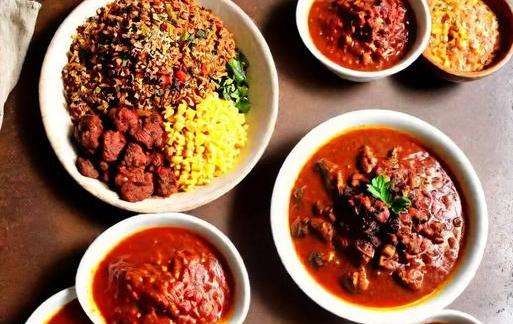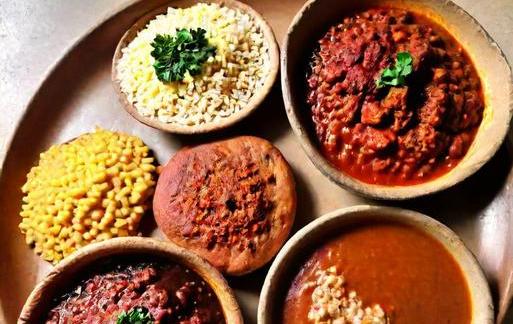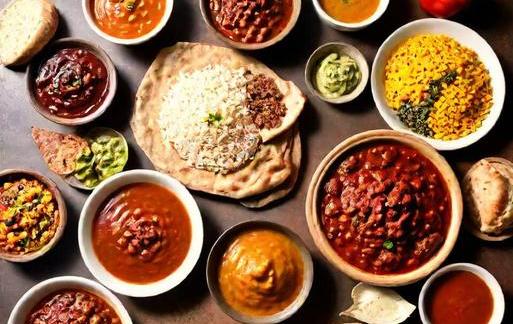- You are here:
- Home »
- Food
- » [REVEALED] African Foods That Start With B
[REVEALED] African Foods That Start With B
Note: This page contains affiliate links.
As an Amazon Associate, I earn from qualifying purchases when you click on the link, but you are not charged extra.
Africa is a vast and diverse continent, home to a rich tapestry of cultures and cuisines. From the spicy flavors of North Africa to the hearty dishes of West Africa, the continent boasts a wide array of delicious foods. In this article, we will explore a list of African foods that start with the letter "B," showcasing the culinary diversity that characterizes this fascinating part of the world.
Contents
List Of African Foods That Start With B

1. Bobotie
Origin: South Africa
Description: Bobotie is a classic South African dish that reflects the country’s multicultural influences. It consists of spiced minced meat, usually lamb or beef, mixed with bread soaked in milk, and topped with an egg-based custard. The dish is baked until golden brown and served with rice or bread. The blend of aromatic spices, such as curry and turmeric, gives bobotie its distinctive flavor.
2. Braai
Origin: South Africa
Description: While not a specific dish, braai is a South African tradition of grilling or barbecuing meat. It represents more than just a method of cooking; it is a social event ingrained in the South African lifestyle. Various meats, from boerewors (sausages) to steaks, are cooked over an open flame. The term "braai" encompasses the entire experience, including the social gathering around the fire.
3. Banku
Origin: Ghana
Description: Banku is a staple dish in Ghana, made from fermented corn and cassava dough. The mixture is cooked into a smooth, elastic consistency and is often served with soups or stews, such as groundnut soup or okra soup. Banku has a slightly sour taste due to the fermentation process, and its doughy texture makes it a perfect accompaniment to rich and flavorful Ghanaian soups.
4. Biltong
Origin: Southern Africa
Description: Biltong is a popular dried and cured meat snack found in Southern African countries like South Africa, Zimbabwe, and Namibia. Typically made from beef, game meats, or ostrich, the meat is marinated in a mixture of vinegar and spices before being air-dried. Biltong has a rich, savory flavor and is enjoyed as a snack or appetizer, often paired with a variety of South African spices.
5. Brik
Origin: Tunisia
Description: Brik is a savory pastry that originated in Tunisia but is also enjoyed in other North African countries. It typically consists of thin layers of dough filled with a mixture of egg, tuna, capers, and sometimes harissa (a hot chili paste). The pastry is folded into a triangular shape and deep-fried until golden and crispy. Brik is known for its delightful combination of textures and flavors.
6. Bunny Chow
Origin: South Africa
Description: Bunny Chow is a South African street food classic that originated in the Indian community of Durban. It involves hollowing out a loaf of bread and filling it with curry, usually made with chicken or mutton. The result is a hearty and flavorful dish that can be eaten with your hands. Bunny Chow has become a symbol of South Africa’s multicultural culinary heritage.
7. Benachin
Origin: Gambia
Description: Benachin, also known as "one-pot" or "jollof rice," is a popular dish in Gambia and other West African countries. It consists of rice cooked with tomatoes, onions, peppers, and various spices. Additionally, protein sources such as chicken, fish, or meat are often added. The dish gets its vibrant color from the tomatoes and is known for its aromatic and flavorful profile.
8. Bambara Beans Soup
Origin: Mali
Description: Bambara beans, also known as Bambara groundnuts, are a nutritious legume native to West Africa. In Mali, they are often used to make a hearty soup. The beans are cooked with vegetables, herbs, and spices, creating a nutritious and satisfying dish. Bambara beans are not only delicious but also a good source of protein, making this soup a staple in Malian cuisine.
9. Babootie
Origin: Namibia
Description: Similar to the South African bobotie, Namibia has its version called babootie. It features spiced and seasoned ground meat, often lamb, mixed with bread soaked in milk. The dish is baked with a layer of egg-based custard on top, resulting in a golden and flavorful masterpiece. Babootie showcases the influence of European and African culinary traditions in Namibian cuisine.
10. Banga Soup
Origin: Nigeria
Description: Banga Soup, also known as Ofe Akwu, is a traditional Nigerian soup that originates from the Igbo ethnic group. The soup is made from palm fruits, which are boiled, pounded, and strained to extract the rich, reddish oil. It is then cooked with various ingredients such as meat, fish, and traditional spices. Banga Soup is often paired with starchy staples like fufu or rice.
11. Boussam
Origin: Chad
Description: Boussam is a traditional Chadian dish made from ground millet or sorghum flour. The flour is mixed with water to form a thick dough, which is then shaped into small cakes and steamed. The result is a dense, slightly tangy food item that can be enjoyed on its own or with sauces. Boussam is a staple in Chadian households, providing a simple yet nutritious source of sustenance.
12. Brik
Origin: Libya
Description: Brik, a popular dish in Libya, is a thin pastry filled with a mixture of egg, parsley, and sometimes meat. The pastry is folded into a triangle and then fried until crispy. It is often served with harissa, a spicy chili paste, adding an extra kick to the flavorful combination of ingredients. Brik showcases the culinary creativity and diversity present in North African cuisine.
13. Boerewors
Origin: South Africa
Description: Boerewors, meaning "farmer’s sausage" in Afrikaans, is a flavorful and spiced sausage that holds a special place in South African cuisine. Made from a blend of beef and pork, seasoned with a mixture of spices such as coriander and cloves, boerewors is often grilled or cooked on an open flame. It is a popular choice at barbecues (braais) and social gatherings throughout South Africa.
14. Bambara Nut Soup
Origin: Senegal
Description: Bambara nuts, also known as earth almonds, are the key ingredient in this traditional Senegalese soup. The nuts are ground into a paste and then cooked with a variety of vegetables, herbs, and spices. The result is a rich and nutty soup that is both flavorful and nutritious. Bambara Nut Soup is a testament to Senegal’s use of indigenous ingredients in creating delicious and unique dishes.
15. Bobotu
Origin: Sierra Leone
Description: Bobotu is a traditional dish from Sierra Leone, featuring a mixture of rice and black-eyed peas cooked in a flavorful broth. The dish is often seasoned with spices and herbs, creating a savory and aromatic experience. Bobotu is a comfort food in Sierra Leone, enjoyed by families and communities alike, showcasing the importance of communal meals in African culture.
African cuisine is a treasure trove of flavors, textures, and culinary traditions. The list of African foods that start with the letter "B" provides a glimpse into the diverse and vibrant culinary landscape of the continent. From the iconic South African braai to the savory Tunisian brik, each dish tells a story of cultural influences, traditional ingredients, and the artistry of African cooking. As we celebrate these African foods, it is essential to recognize the significance of food in African culture. Meals are not merely a means of sustenance; they are a reflection of history, identity, and communal bonds. Whether enjoyed at a festive gathering or a simple family meal, these dishes connect people to their roots and showcase the richness of Africa's gastronomic heritage. Exploring African foods that start with "B" is not just a culinary journey; it is an invitation to appreciate the depth of diversity and creativity that defines African cuisine. As we savor the flavors of bobotie, braai, and banga soup, let us embrace the cultural richness and culinary excellence that make African food a truly extraordinary experience.
Significance

Africa, a vast and diverse continent, is a treasure trove of culinary delights waiting to be explored. In this gastronomic journey, we delve into the world of African foods that start with the letter “B”. From the vibrant street markets to the traditional kitchens, the culinary landscape of Africa offers a rich tapestry of flavors, aromas, and textures. Join us on this epicurean adventure as we unravel the significance, categories, common themes, and interesting facts surrounding these delectable African foods.
African cuisine is a reflection of the continent’s cultural diversity, history, and geographical variations. Each region boasts a unique culinary identity, shaped by indigenous ingredients, traditional cooking methods, and historical influences. Exploring foods that start with ‘B’ allows us to appreciate the culinary nuances that make African gastronomy truly exceptional.
These foods not only serve as sustenance but also play a crucial role in social and cultural gatherings. Meals are often a communal affair, fostering a sense of unity and shared identity. Furthermore, the significance of certain ingredients and dishes in African rituals and ceremonies adds an extra layer of cultural depth to the culinary landscape.
Category-Related

1. Biltong
Originating from Southern Africa, biltong is a form of dried, cured meat, often made from beef. The meat is marinated in a mixture of vinegar, salt, sugar, and spices before being air-dried. This traditional method of preservation has been a culinary practice for centuries, allowing communities to store meat for extended periods, especially in regions with limited access to refrigeration.
Biltong is not only a popular snack but also a source of pride for many Africans, celebrating their heritage through this flavorful and protein-rich delicacy.
2. Bobotie
Hailing from South Africa, bobotie is a savory, spiced minced meat dish baked with an egg-based topping. The blend of aromatic spices, including curry, turmeric, and coriander, gives bobotie its distinctive flavor profile. It is often served with rice or bread, creating a satisfying and hearty meal.
Bobotie showcases the fusion of flavors that characterizes much of African cuisine, drawing influences from indigenous ingredients and the culinary traditions brought by settlers and traders.
3. Banku
In West Africa, particularly in Ghana, banku is a staple dish made from fermented corn and cassava dough. The dough is cooked to a smooth, elastic consistency and served as an accompaniment to soups and stews. Its sour taste, a result of the fermentation process, adds a unique dimension to the meal.
Banku exemplifies the resourcefulness of African cooking, utilizing local ingredients and traditional techniques to create a dish that is not only delicious but also culturally significant.
4. Bunny Chow
Originating from the Indian community in South Africa, bunny chow is a beloved street food. It consists of a hollowed-out loaf of bread filled with curry, often made with chicken or mutton. This dish is a testament to the cultural amalgamation that defines South African cuisine, blending Indian flavors with local ingredients.
Bunny chow’s popularity has transcended its origins, becoming a symbol of South Africa’s multicultural culinary landscape.
Common Themes
African foods that start with ‘B’ often share common themes that highlight the continent’s culinary identity.
1. Use Of Indigenous Ingredients
One recurring theme is the reliance on indigenous ingredients that are unique to each region. Whether it’s the grains, tubers, or spices, African cuisine celebrates the diversity of the continent’s flora.
2. Culinary Diversity
The sheer variety of dishes starting with the letter ‘B’ is a testament to the culinary diversity within Africa. From hearty stews to spiced meats, each dish represents a different facet of African gastronomy.
3. Cultural Significance
Many of these foods have cultural and ritualistic significance. They are not just nourishment but also play a crucial role in ceremonies, celebrations, and communal gatherings.
4. Adaptation And Fusion
African cuisine has a history of adapting to external influences. Dishes like bunny chow showcase the fusion of different culinary traditions, resulting in a unique and flavorful outcome.
Interesting Facts
1. Bobotie’s Historical Roots
Bobotie’s origins can be traced back to the Cape Malay community in South Africa. It is believed to have been influenced by Indonesian and Dutch culinary traditions brought by slaves and settlers. The dish has evolved over centuries, incorporating local ingredients to become the iconic dish it is today.
2. Banku And Fermentation
The fermentation process used in making banku not only imparts a distinctive flavor but also enhances the nutritional value of the dish. Fermentation increases the bioavailability of nutrients, making banku a wholesome and beneficial addition to the West African diet.
3. Bunny Chow’s Street Food Fame
Bunny chow’s rise to fame as a street food staple in South Africa is a testament to its deliciousness and accessibility. What started as a humble meal served in a loaf of bread has become a symbol of South African street food culture, enjoyed by people from all walks of life.
4. Biltong’s Cultural Heritage
Biltong holds a special place in South African culture, often enjoyed during social events, sports gatherings, and as a snack during outdoor activities. Its roots can be traced back to the indigenous Khoikhoi people, who used similar drying methods to preserve meat in the harsh African climate.
Conclusion
The exploration of African foods that start with ‘B’ takes us on a captivating journey through the continent’s culinary landscape. From the savory delights of bobotie to the cultural significance of banku, each dish tells a story of tradition, adaptation, and celebration.
As we savor the flavors and aromas of these African delicacies, we gain a deeper understanding of the diverse cultures that contribute to the continent’s rich tapestry. The significance, categories, common themes, and interesting facts surrounding these foods provide a glimpse into the heart of African gastronomy, inviting us to appreciate the artistry and heritage embedded in each dish that graces the tables of this extraordinary continent.


